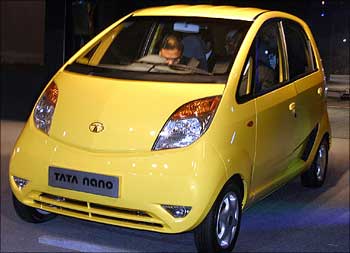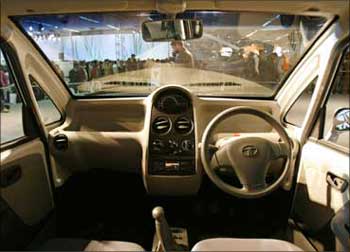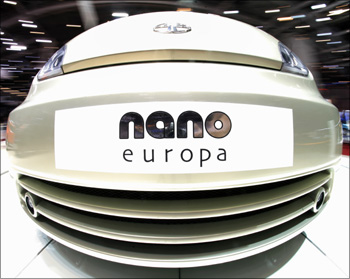
A year ago, Tata Nano, the cheapest car on the planet, received rave reviews from across the world. Today, the one-year-old Nano is facing one of its toughest tests after the car burst into flames on two occasions, shocking people across the country.
A brand new Tata Nano caught fire in Mumbai on March 21 while its owner and his family were driving it from the showroom to their home. Luckily they escaped unhurt as they got out of the vehicle as soon as they detected smoke emanating from the car's rear.
Another brand new Nano was reduced to flames while it was being taken to the showroom in Ahmedabad on April 7. Here, too, fortunately the driver escaped unhurt.
Earlier, instances of 'minor fire' were reported from vehicles in Lucknow, Delhi and Ahmedabad. According to Tata Motors, only five cars out of the 30,000 Nanos on the road were reported to have developed problems. Of these only two cars were completely burnt. The other three cars were repaired and given back to the owners.
"There is no fundamental design flaw in the cars. We are carrying out an investigation into what led to the fire. We will also do a pre-emptive safety audit to ensure there are no problems," says Debasis Ray, spokesman, Tata Motors.
However, experts say it is a problem with the rear engine. "The rear engine does not have a proper cooling system as a result of which the engine heats up leading to such an incident. The summer season will be the toughest test for the Tata Nano," says Mahendra Dhruva, national president, The Institute of Insurance Surveyors and Adjusters (IISA).
. . .

"There is not enough space and ventilators are not enough to provide sufficient air circulation. In cities where temperatures in the summer shoot up close to 48-50 degree Celsius, it is difficult to manage this car if the cooling systems are not functioning properly," he says.
"In a rear engine, the air does not get circulated properly, which could lead to over heating of the engine. The coolant capacity must be optimised and a different coolant other than ethylene glycol, which is normally used, must be tried," says M Senthil Kumar, professor, automobile engineering, Madras Institute of Technology.
"It is scary to think that this car can catch fire. Luckily nothing has happened to my car," says a Tata Nano owner who has completed 8,000 kilometres.
"It will be a trial and error method for Tata Nano. It is not a major problem that cannot be rectified. They have a research team which I am sure will look at this heating problem. Incidentally, earlier Volkswagen cars with a rear engine too faced the same problem of overheating," says Dhruva.
Yet another car enthusiast points towards the lack of sufficient cooling as the Nano has a rear engine. In other cars, fresh air gets circulated as the engine is in the front. Even if the fan gets stuck, the engine can get overheated quickly.
In three Nanos, Tata Motors detected the problem with the combination switch so the company changed the supplier. Smoke was found near the steering area, even when the car was parked due to which the area around the combi-switch melted.
. . .

"The company will do everything possible to address the concerns of the customers. The customer whose car was burnt was given the option of taking a new car or taking the refund. He opted for the latter," adds Ray.
Since the engine is placed under the rear seat, it is not possible for owners to easily check the engine without removing the rear seat.
Bhupendra Jani, a doctor based in Ahmedabad, had recounted a harrowing time when he detected sparks emanating from the front panel of the car after the parking lights were kept on for about 4 hours last year. "It was very scary at it happened around midnight. We got really worried. Luckily the sparking stopped on its own. The wiring inside the front panel got burnt. The next day mechanics came and repaired it and said it was due to a loose connection," Jani said.
"You cannot expect the safest and best quality in a car when you are going for a cheap car," says an industry official.
The Tata Nano fire incident has slightly dented the reputation of the much-hyped car. With problems plaguing the Tata Nano in India, how does the company plan to export the car? The company's first target is to complete the delivery of 100,000 cars in India. "Exports will take place after it completes this target," says Ray.
While Tata Motors is still investigating the reasons for the fire, owners who were jubilant to be among the first to own a Nano are now treading with caution.